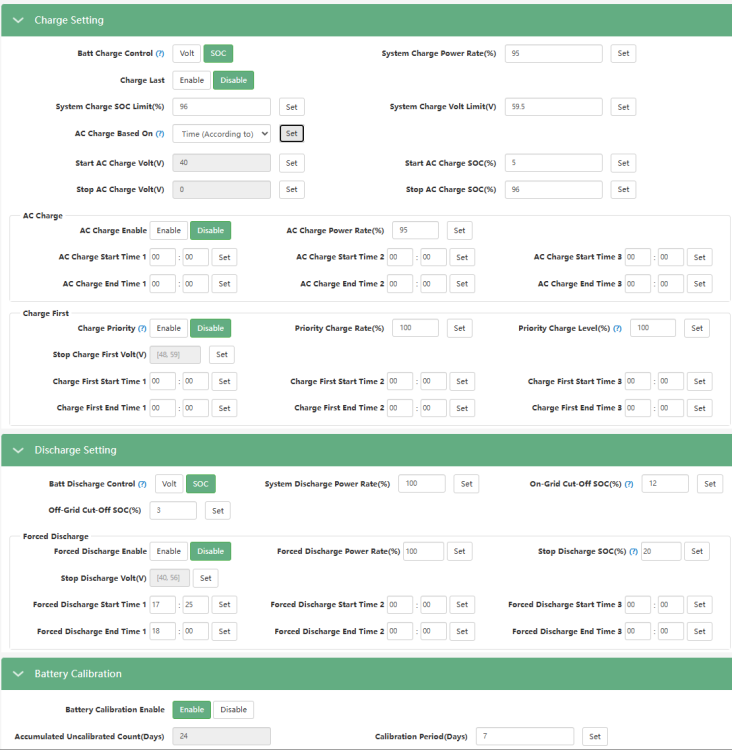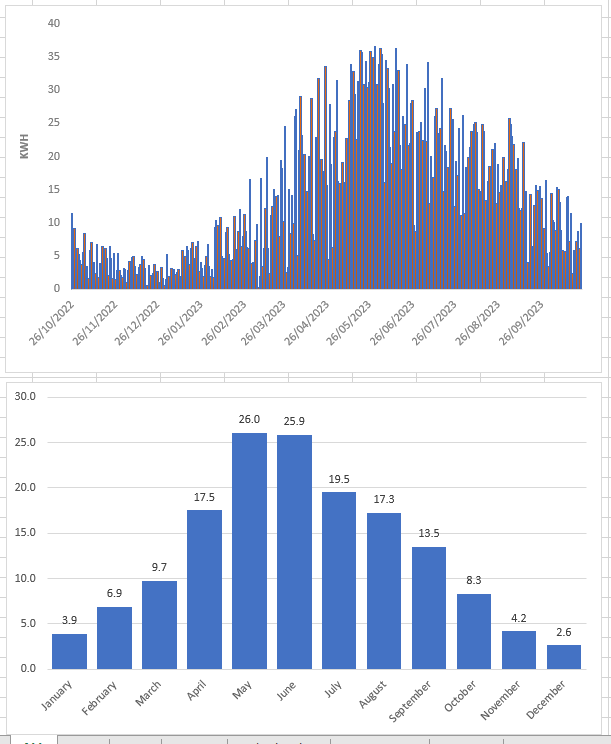
MrTWales
Members-
Posts
194 -
Joined
-
Last visited
Recent Profile Visitors
The recent visitors block is disabled and is not being shown to other users.
MrTWales's Achievements

Regular Member (4/5)
12
Reputation
-
Just to add, in case anyone else has this issue - the system was apparently trying to charge at 00:00 due to battery callibration, where it tries to charge to 100% but couldn't as the limit is set to 96% so it kept trying. I never changed any settings but it looks like if you click on the "enable" to calibrate then you need to change the SOC charge limit to 100% until it's gone through one cycle.
-
Hi, I have a Luxpower Hybrid Inverter 6K [LXP-6K Hybrid] and it's been working properly for a couple of years but recently it's not been working as it should. I'm going through the support email address and they are getting back with the odd thing, but once they updated the firmware it's got even worse. They've not got back for a couple of days so I'm just seeing if I can find a way to get the damn thing to work. The webpage interface has changed recently so I guess the issues may be related to this but it's been hopeless. The recent issues are: - using time slots and SOC to charge no longer works. Apparently this is a design issue but it used to work. Now you have to set the charge at night for period, or else set the system to charge when the battery SOC reduces to a certain level. So, for example, you can't now charge the battery to 30% at 4am-5am. It's a bit crap but hopefully it will change. - the forced discharge stopped working, but now it is. - the battery isn't used at 00:00 no matter what the battery SOC is. I've gone through every setting and can't for the life of me see any setting that should even lead to this happening (the battery isn't charging at 00:00, it's just not used). - Luxpower updated the firmware but now it's even worse! At 00:00 the battery gets changed at the max level. This is even when AC charge is disabled and all time slots are 00:00 (ie nothing is even set). - all I can do is set the overall battery max charge level to something small at night, and then change it back in the morning so the solar charges the battery. This stops the battery charging but the battery still isn't used at 00:00. If anyone can suggest something that I could try it would be appreciated! I've pasted the main settings, both the new and old look options.
-
Thanks, that is interesting. There is another setting elsewhere where the battery is stopped from going below a certain point (6% or thereabouts) and this setting is only in the charge section. At the moment it shows a zero but this is out of range so I guess it's assuming the default, whatever that is.
-
I really have tried to find out but there is nothing in the manual, or any similar manual online - though many have a similar page to the page below but without this parameter. I get what "System Charge Power Rate(%)" is, though is there any reason it's bad to put in 100%? Looking looking online most of the time it's 80% or something like that. I'm not sure if this overrides the "AC Charge Power Rate(%)" parameter but I'll just set them as being the same. I get what "Stop AC Charge SOC(%)" means, even I can understand that! But what is "System Charge SOC Limit(%)"? If the page isn't loaded up then it wants a [10,101] range but it doesn't like anything if I put a figure in and press "set". I think I changed this recently, thinking it was the previous field by mistake, so I don't know what it was previously set as and I can't seem to set everything to default either. My inverter is called LXP Hybrid Inverter 6K [LXP-6K Hybrid]. Any clues would be appreciated!
-
Ah thanks for this. I wasn't aware of this - I thought that you could have Flux Export only with Flux Import, but I wasn't aware of any other options. When I can face it I'll think it through and get it sorted. My inverter has a fair number of options but not quite as many as I'd like, but I can set several windows to imports / push to the grid.
-
I'm one day shy of a full year with panels and it's amazing how generation varies. Not just by month but by day. I know it's kind of obvious but one day can be three times the previous day very easily. My system is 12*410w panels at only 10 degrees on a flat roof, so bad for winter but it was an easy install and I can clean myself etc. The chart shows the amazing May and crappy July/August that we had!
-
Oww...I'm on Flux but it looks like I should be thinking about Cosy. What I'm worried about is judging how much to charge the battery. If it gets full in the day then I'm at least getting an export amount paid now, but this stops with Cosy? I guess it's less of an issue each day and you can top up to a certain figure before the high import rates start.
-
As others have said, shading is a big issue potentially and another is weight. The usual fitting method with a flat roof I believe is ballast, so they add concrete to the fixing brackets. With the panels maybe being 20kg each that's a lot of weight so the rafters need to be strong enough.
-
No worries - at the moment my usage charge is a decent credit, but in the winter I may be better off with a different tariff. I suspect the best ones for those with a decent sized battery will require an EV.
-
What are the export rates? I don't have an EV so I'm not sure it's an option for me though anyway.
-
Well, being on this tariff certainly makes things interesting. As far as I can see I can't change the priority discharge ordering in the inverter settings (to using the battery first) in the evening Flux period of 4pm to 7pm, but I can force a battery discharge. But if I discharge at 25% say, which is 1kw in my case, then it just pushes this much out and won't increase if the load is higher. If I discharge at 100% then the export is 4kw + solar - useage, which can be loads. The downside is potentially depleting the battery and having to import at the highest rate. It seems to me that the best solution is to ignore the first part of the Flux period and set the discharge from something like 6pm to be 100% with a cut off whereby the battery doesn't get below a certain point. The latter is just because it may mean importing at the heighest rate if the battery runs out, but not leaving much battery at 7pm isn't a disaster as the Flux export rate is probably very close to the standard import once effeciency has been factored in. There then is the Flux period from 2am to 5am. After efficiency it seems like importing then and exporting at the standard rate is virtually break even, maybe a tiny gain. So there is probably merit to just fully charging the battery in this period. I think I'll not bother recharging when the weather is good as the battery will get to 100% before 4pm on most summer days, but otherwise charge to a specific percentage figure.
-
Advice please: solar diverter install
MrTWales replied to crispy_wafer's topic in Photovoltaics (PV)
I take there is no gas installed? If so and you can get on something like the Octopus Flux tariff then it's cheaper to use gas for water than to reduce the export. Fwiw I had a water diverter installed way after the main installation (they just ran out of time on the day) and it was maybe 90 mins or so to install if not less when they finally came back. It looked simple for any electrician to be honest. -
Just to update this - I am now on the Flux Export Tariff. For anyone doing through this process, it's worth calling Octopus if there are any delays. Eg the MSC cert had the wrong MPAN code so I had to get the installer to change this and send it on (it wasn't their fault fwiw), and when I called Octopus after a few days to make sure they had it it was just sat there but the moment I called it got forwarded on. Also, when the export was set up it it showed incorrectly in the app (as if it was an import on the variable tariff) but a quick call got it flagged correctly. So now I can see that I exported 19.1 kWh yesterday (being on holiday now!), compared to 19.4 kWh as per the inverter app. So that seems pretty good, with £3.93 credit.





